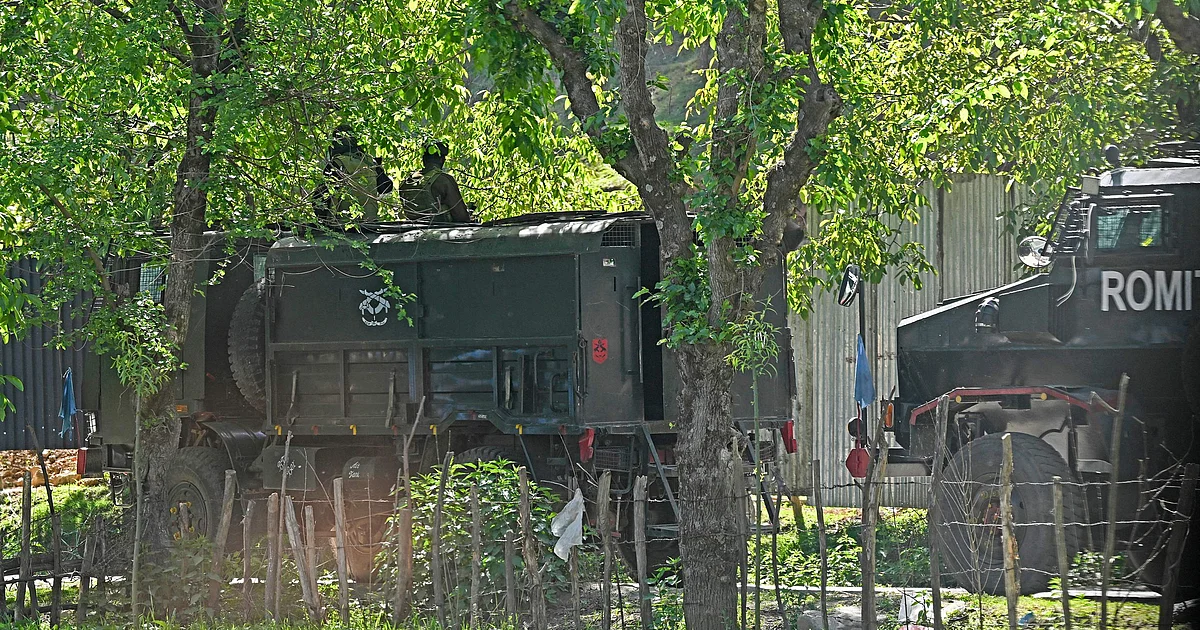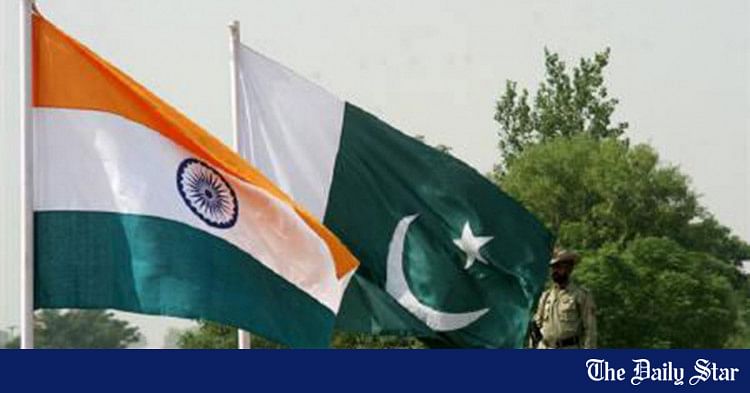Saif
Senior Member
- Joined
- Jan 24, 2024
- Messages
- 15,941
- Likes
- 7,996
- Nation

- Axis Group


India, Pakistan and the Kashmir attack: What we know
Long-troubled relations between nuclear-armed rivals India and Pakistan have rapidly worsened since a deadly attack in Kashmir targeting tourists that New Delhi blames on Islamabad, accusations it has firmly rejected.
India, Pakistan and the Kashmir attack: What we know
AFP New Delhi
Published: 29 Apr 2025, 20: 56

Indian army patrols on way to Hapatnar in Anantnag district south of Kashmir on 29 April 2025. AFP
Long-troubled relations between nuclear-armed rivals India and Pakistan have rapidly worsened since a deadly attack in Kashmir targeting tourists that New Delhi blames on Islamabad, accusations it has firmly rejected.
One week since the 22 April attack in which 26 men were killed, the deadliest on civilians in the disputed Himalayan territory in a quarter of a century, analysts worry furious rhetoric on either side may escalate into military retaliation.
What happened?
Gunmen attacked Indian holidaymakers enjoying picturesque Pahalgam, in a lush valley beneath snowcapped Himalayan peaks.
Survivors said the gunmen separated the men, asked several about their religion, and shot them at close range.
All 26 killed were Indian nationals, except one from Nepal. Most were Hindus. One was a Kashmiri Muslim who gave horse rides for tourists.
Prime Minister Narendra Modi has vowed to pursue the killers "to the ends of the Earth".
Who were the attackers?
Indian police have identified two Pakistani nationals among the three fugitive alleged gunmen. The other is Indian.
Police say they are members of the Pakistan-based Lashkar-e-Taiba (LeT), meaning the "Army of the Righteous", designated a terrorist organisation by the United Nations.
No group has claimed responsibility.
India accuses LeT of the 2008 Mumbai attacks, when 10 Islamist gunmen carried out a multi-day siege of the country's financial capital killing 166 people
New Delhi last week accused Islamabad of supporting "cross-border terrorism".
Pakistan has denied any role in the Pahalgam attack, rejecting Indian accusations as "frivolous" and saying it was open to a "neutral, transparent and credible" investigation.
What is the issue in Kashmir?
Muslim-majority Kashmir has been divided between India and Pakistan since their independence from British rule in 1947. Both claim the territory in full.
Rebels in the Indian-run area have waged an insurgency since 1989, seeking independence or a merger with Pakistan.
India has an estimated 500,000 soldiers deployed permanently in the territory.
India accuses Pakistan of funding the rebels and aiding their training. Islamabad denies the allegation, saying it only supports Kashmir's struggle for self-determination.
How has India responded?
New Delhi has also issued a raft of punitive diplomatic measures.
Those include suspending a water-sharing treaty, the closure of the main border crossing with Pakistan and downgrading diplomatic ties.
India has ordered all Pakistani nationals to leave the country, with the exception of remaining diplomats, by 29 April.
Security forces have conducted more than 2,000 detentions and interrogations, according to a police source.
The military also destroyed at least nine houses belonging to suspects, fueling the anger of some local officials and a section of the population who denounced it as "collective punishment".
India has also banned more than a dozen Pakistani YouTube channels for allegedly spreading "provocative" content.
How has Pakistan responded?
Pakistan hit back with tit-for-tat measures, including expelling New Delhi's diplomats, and cancelling visas for Indian nationals with the exception of Sikh pilgrims.
It also closed its airspace to Indian airlines.
Islamabad also warned it would regard any attempt by India to stop the supply of water from the headwaters of the Indus River as an "act of war".
Pakistan's defence minister has claimed to have "reinforced" its military to repulse any Indian aggression.
What will happen next?
Some fear that military action is now imminent.
The two countries have traded small arms fire across the Line of Control, the de facto border in contested Kashmir, for five consecutive nights.
The worst attack in recent years in Indian-run Kashmir was at Pulwama in 2019, when an insurgent rammed a car packed with explosives into a security forces convoy, killing 40 and wounding 35.
Indian fighter jets carried out air strikes on Pakistani territory 12 days later.
AFP New Delhi
Published: 29 Apr 2025, 20: 56
Indian army patrols on way to Hapatnar in Anantnag district south of Kashmir on 29 April 2025. AFP
Long-troubled relations between nuclear-armed rivals India and Pakistan have rapidly worsened since a deadly attack in Kashmir targeting tourists that New Delhi blames on Islamabad, accusations it has firmly rejected.
One week since the 22 April attack in which 26 men were killed, the deadliest on civilians in the disputed Himalayan territory in a quarter of a century, analysts worry furious rhetoric on either side may escalate into military retaliation.
What happened?
Gunmen attacked Indian holidaymakers enjoying picturesque Pahalgam, in a lush valley beneath snowcapped Himalayan peaks.
Survivors said the gunmen separated the men, asked several about their religion, and shot them at close range.
All 26 killed were Indian nationals, except one from Nepal. Most were Hindus. One was a Kashmiri Muslim who gave horse rides for tourists.
Prime Minister Narendra Modi has vowed to pursue the killers "to the ends of the Earth".
Who were the attackers?
Indian police have identified two Pakistani nationals among the three fugitive alleged gunmen. The other is Indian.
Police say they are members of the Pakistan-based Lashkar-e-Taiba (LeT), meaning the "Army of the Righteous", designated a terrorist organisation by the United Nations.
No group has claimed responsibility.
India accuses LeT of the 2008 Mumbai attacks, when 10 Islamist gunmen carried out a multi-day siege of the country's financial capital killing 166 people
New Delhi last week accused Islamabad of supporting "cross-border terrorism".
Pakistan has denied any role in the Pahalgam attack, rejecting Indian accusations as "frivolous" and saying it was open to a "neutral, transparent and credible" investigation.
What is the issue in Kashmir?
Muslim-majority Kashmir has been divided between India and Pakistan since their independence from British rule in 1947. Both claim the territory in full.
Rebels in the Indian-run area have waged an insurgency since 1989, seeking independence or a merger with Pakistan.
India has an estimated 500,000 soldiers deployed permanently in the territory.
India accuses Pakistan of funding the rebels and aiding their training. Islamabad denies the allegation, saying it only supports Kashmir's struggle for self-determination.
How has India responded?
New Delhi has also issued a raft of punitive diplomatic measures.
Those include suspending a water-sharing treaty, the closure of the main border crossing with Pakistan and downgrading diplomatic ties.
India has ordered all Pakistani nationals to leave the country, with the exception of remaining diplomats, by 29 April.
Security forces have conducted more than 2,000 detentions and interrogations, according to a police source.
The military also destroyed at least nine houses belonging to suspects, fueling the anger of some local officials and a section of the population who denounced it as "collective punishment".
India has also banned more than a dozen Pakistani YouTube channels for allegedly spreading "provocative" content.
How has Pakistan responded?
Pakistan hit back with tit-for-tat measures, including expelling New Delhi's diplomats, and cancelling visas for Indian nationals with the exception of Sikh pilgrims.
It also closed its airspace to Indian airlines.
Islamabad also warned it would regard any attempt by India to stop the supply of water from the headwaters of the Indus River as an "act of war".
Pakistan's defence minister has claimed to have "reinforced" its military to repulse any Indian aggression.
What will happen next?
Some fear that military action is now imminent.
The two countries have traded small arms fire across the Line of Control, the de facto border in contested Kashmir, for five consecutive nights.
The worst attack in recent years in Indian-run Kashmir was at Pulwama in 2019, when an insurgent rammed a car packed with explosives into a security forces convoy, killing 40 and wounding 35.
Indian fighter jets carried out air strikes on Pakistani territory 12 days later.









































